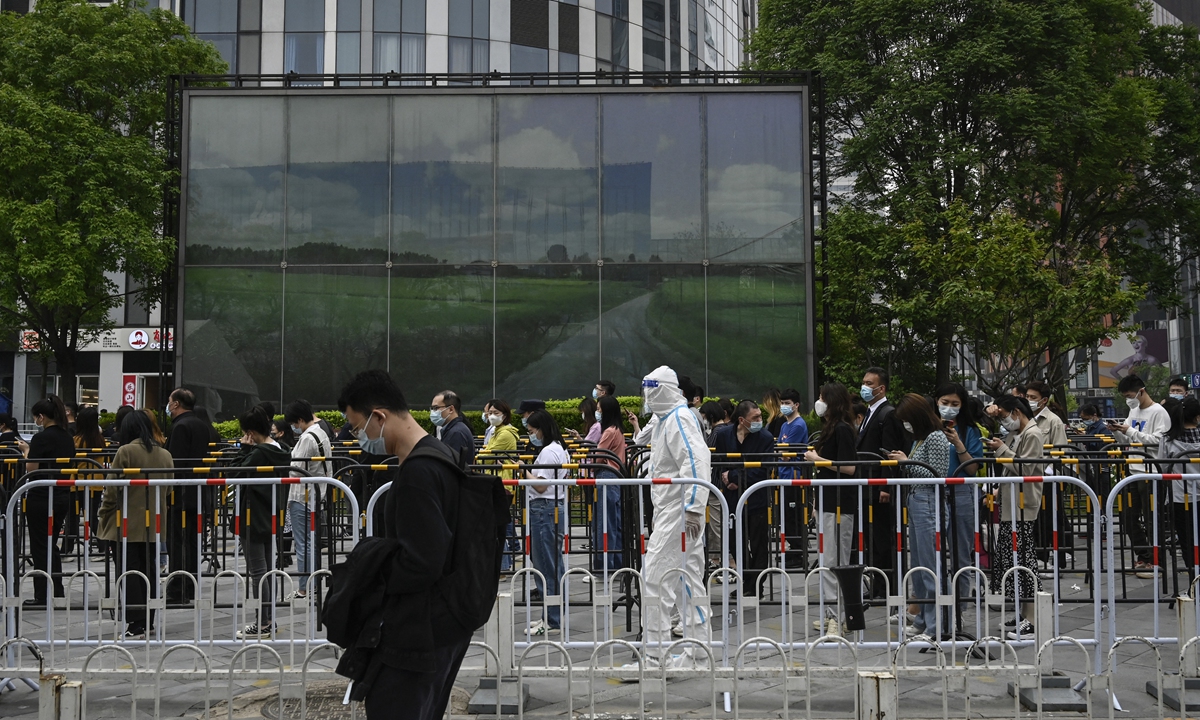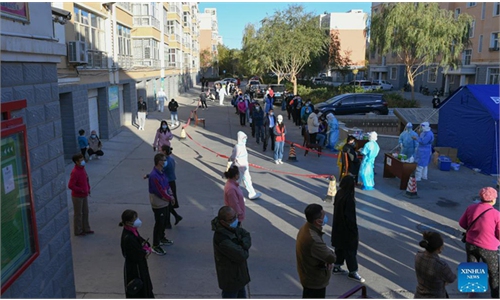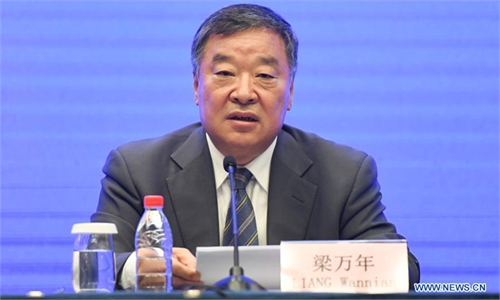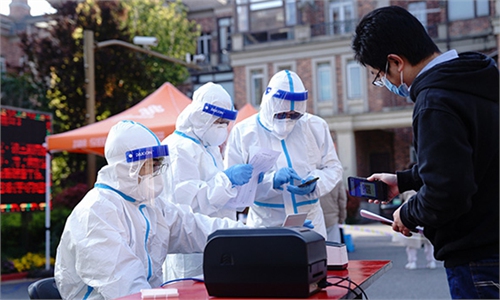US responsible for Shanghai surge
‘Live with virus’ policy would mean mass deaths for China

People wait in line to be tested for COVID-19 at a swab collection site in Beijing on April 25, 2022. Photo: AFP
In the face of intense pressure to end the zero-COVID-19 policy, the horrific outbreak in Shanghai has at last come under control with daily infection rates declining from 20,000 to 4,000 by Wednesday. Heroic efforts by tens of thousands of medical personnel, city workers, volunteers and the firm resolve of the central government to protect the Chinese people from COVID-19 is succeeding.Using the Shanghai outbreak as a pretext, the US and Western world's corporate media have again repeatedly slammed the zero-COVID-19 policy in recent days, essentially demanding that China give up zero-COVID-19.
We have no wish to deny that Shanghai's government and people were not well-prepared to deal with a novel and unprecedented massive outbreak of the super-infectious Omicron B2 subvariant. Some Chinese netizens and others have proposed that the restrictions intended to quell the virus were too strict, and contributed to unnecessary suffering. Children separated from their parents when they contracted COVID-19 before the policy was reversed; elderly folks temporarily unable to access medical care; and temporary food shortages in some areas, with some lockdowned residents chanting "we want to eat" and "we want freedom," are some of the reported incidents.
But with no precedent to guide them, and in an unprepared city like Shanghai, creating a completely new supply chain to handle food deliveries, medical care, and other daily necessities of 25 million people takes time and mistakes are inevitable. Western media coverage of the genuine suffering entailed in the incidents reported by a minority of Shanghai residents has, however, made little or no mention of strong Shanghai and central government efforts to resolve these problems, nor of the lessons learned.
Typical is the article entitled "China's 'Zero Covid' Mess Proves Autocracy Hurts Everyone" published by the New York Times.
The article describes a number of difficulties encountered by Shanghai residents, and cites a number of zero-COVID-19 critics both within and outside China claiming that "the zero-COVID-19 policy harms the Chinese people."
What this article, and those like it calling for an end to zero-COVID-19, intentionally avoid is the reality that when they call for an end to zero-COVID-19 they are calling for the deaths of 1 million or more people in China, with one look at the COVID-19 death numbers for countries like the US enough to demonstrate this. Due to their government's refusal to follow China's example, more than 1 million Americans have died from COVID-19, while nearly 2 million residents of the EU have also succumbed. Meanwhile, only 4,500 Chinese people have died from COVID-19 due to the implementation of zero-COVID-19.
This point bears emphasis: The reality that should be at the center of any honest discussion of zero-COVID-19 in American media is that 1 million Americans are dead due to the anti-zero-COVID-19 policy promoted by corporate media journalists, while just 4,500 Chinese people have died under zero-COVID-19. Moreover, thousands of Americans and Europeans continue to die each week from COVID-19. And one out of every 100 persons over 65 have died in the US due to non-zero-COVID-19.
Moreover, the American association of physical scientists estimates that 10 million Americans are suffering from long COVID, which is the persistence of serious health conditions long after the initial COVID-19 infection is gone. The renowned Mayo Clinic in the US reports that the virus can damage the lungs, heart and brain, which increases the risk of long-term health problems. In fact, large numbers of those suffering from long COVID report persistence even after one or two years, and the longevity of these conditions is not yet known and could last a lifetime.
Failure to include the comparative numbers, and a failure to emphasize or even mention long COVID, in virtually all of the Western media accounts of China's Shanghai difficulties shows irrefutably the motive is not to report accurately on China's COVID-19 policy but to serve two political goals.
First, it is intended to prevent Western people from recognizing that there is an alternative proven in China to mass infections and mass deaths, and that their governments have prioritized business profits over people's lives by maintaining business operations no matter the cost in mass infections, deaths, and long COVID.
The second political goal is to further demonize China's government as part of the multi-sided economic, military, and information campaign to prepare the Western public to accept further aggressive moves against China, which may even lead to war.
There is something called a "lie of omission" which entails omitting key information in order to convey a false picture of reality. The Western media's accounts of the difficulties and supposed growing public resistance to zero-COVID-19 in China never mention what should be the major news point regarding the global pandemic and China's zero-COVID-19 policy: The stark contrast between millions of COVID-19 deaths which continue to mount outside China and just 4,500 COVID-19 deaths inside China.
Finally, there is no question that the COVID-19 policies of the Western governments promoted by their corporate media, with the US as the exemplar, are fundamentally responsible for the Shanghai surge. The existence of the highly infectious Omicron B2 mutation which has ravaged Shanghai is the result of the US and other governments allowing hundreds of millions of people to be infected with COVID-19, thereby enabling sufficient human breeding grounds for mutations to produce the Omicron B2 subvariant and new and even more lethal variants in the future.
The author is a Canadian independent researcher specializing in social, political, and information technology subjects.
The views do not necessarily reflect those of the Global Times.



